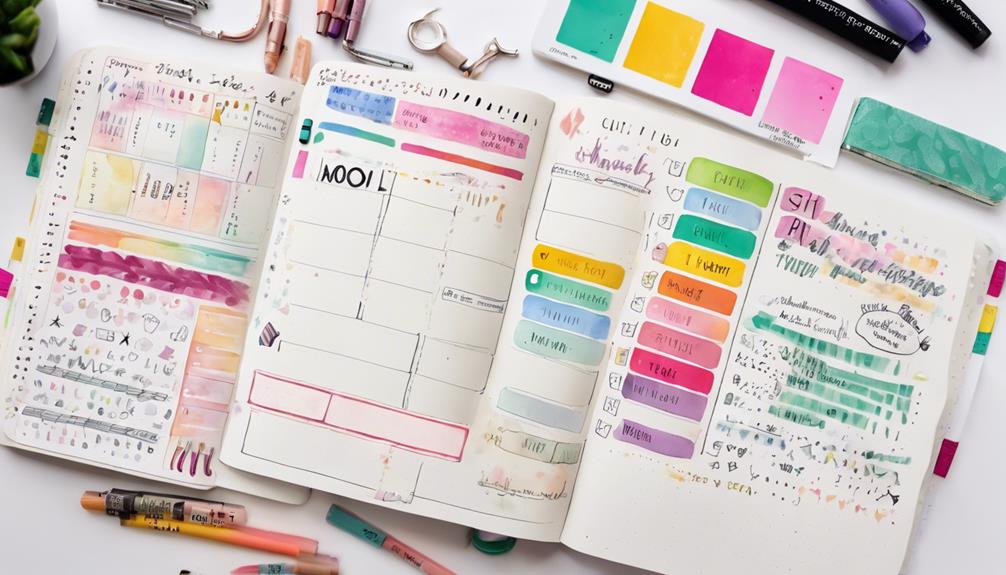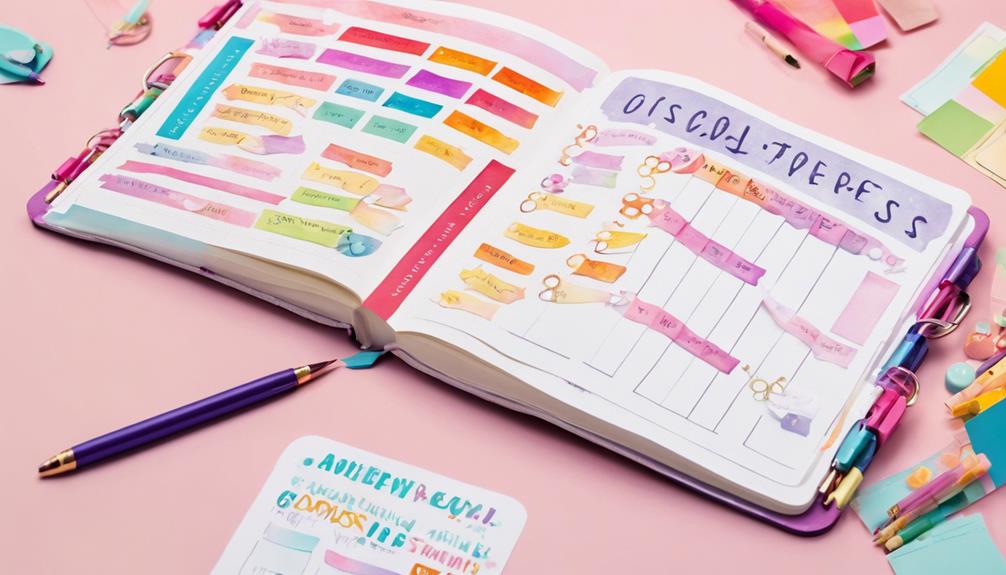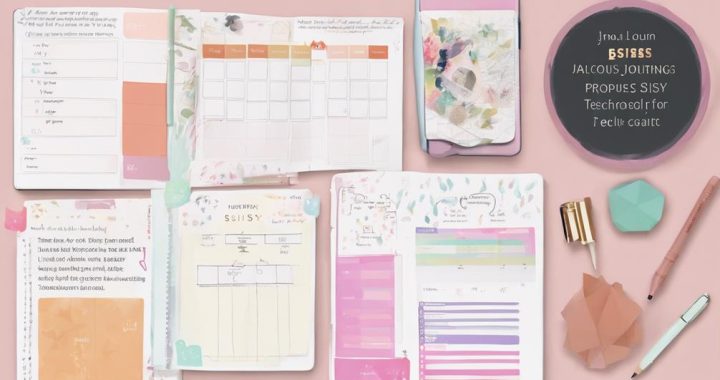To track your sissy progress effectively, start by reflecting daily on your journey. Set clear goals with achievable targets and break them down into smaller steps. Use visual aids like vision boards and doodle diaries to enhance motivation. Track your mood changes alongside workouts to understand emotional impact. Celebrate your achievements with milestone rewards to stay motivated. Incorporate feedback from trainers or workout buddies for valuable insights. Mastering these journaling techniques will help you gain deeper insights and foster continuous growth in your fitness journey.
Benefits of Daily Reflection

Reflecting on your daily fitness journey can provide valuable insights into your progress and areas for improvement. By taking the time to journal your experiences, you have the opportunity to cultivate improved self-awareness and enhanced mindfulness. Through daily reflection, you can gain a deeper understanding of your habits, behaviors, and emotional responses related to your fitness routine.
Journaling allows you to track your progress over time, helping you identify patterns and trends that may impact your fitness goals. This process of self-reflection enables you to celebrate your achievements and acknowledge the challenges you have faced. It also empowers you to make informed decisions about adjustments that may be necessary to continue moving forward on your fitness journey.
Moreover, daily reflection encourages you to stay present and engaged in your fitness activities. By tuning into your thoughts and feelings during exercise, you can develop a stronger mind-body connection and optimize your performance.
Embracing the practice of journaling for daily reflection can lead to a more fulfilling and holistic approach to your fitness routine.
Setting Clear Goals
To propel your fitness journey forward with purpose and direction, it's imperative to establish clear and achievable goals. Setting specific milestones allows you to track your progress effectively and stay motivated along the way.
When defining your goals, consider what you want to achieve and break it down into smaller, measurable objectives. For example, if your ultimate goal is to run a 5k race, your specific milestones could include running a certain distance without stopping or improving your pace over time.
Progress indicators are key elements in goal setting. These are measurable criteria that demonstrate you're moving in the right direction. Progress indicators could be things like the number of days you stick to your workout routine each week, improvements in your strength or endurance levels, or reaching a specific weight or body fat percentage.
Using Visual Aids

Visual aids play an essential role in enhancing your fitness tracking experience by providing clear and tangible representations of your progress. Get creative with your journaling by incorporating vision boards, doodle diaries, and photo collages.
Vision boards are a powerful tool to visually represent your fitness goals and aspirations. By cutting out images of your ideal physique, workout routines, or healthy meals, you can manifest these desires into reality.
Doodle diaries offer a fun and expressive way to track your daily activities, feelings, and achievements. Use colorful drawings and annotations to capture your fitness journey in a personalized and engaging manner.
Photo collages are perfect for showcasing before and after photos, progress snapshots, or inspirational quotes. Seeing these visual reminders can boost your motivation and keep you focused on your goals.
Experiment with different visual aids to find what resonates best with you and watch as they bring a new dimension to your fitness tracking routine.
Tracking Mood Changes
Consider incorporating mood tracking into your fitness journal to gain insight into how your emotions may impact your overall progress. Mood journaling can be a powerful tool in understanding your emotional fluctuations and their effects on your fitness journey.
By consistently tracking your mood alongside your workouts and nutrition, you can start recognizing patterns and triggers that influence your motivation, energy levels, and performance.
Progress tracking isn't just about physical changes; it's also about self-awareness and emotional well-being. When you log how you feel before and after your exercise sessions, you can begin to see correlations between your mood and your commitment to your fitness routine.
This can help you identify moments when you might be more prone to skipping workouts or making unhealthy choices.
Celebrating Achievements

When you achieve milestones in your fitness journey, taking the time to celebrate these accomplishments can provide motivation and reinforcement for your hard work and dedication. Implementing a reward system for yourself can be a powerful tool to acknowledge your progress.
Set specific milestones, such as completing a certain number of workouts or reaching a weight loss goal, and decide on a corresponding reward, like treating yourself to a massage or buying new workout gear. These milestone celebrations not only recognize your achievements but also serve as positive reinforcement, reinforcing your commitment to your fitness goals.
In addition to celebrating specific milestones, incorporating regular progress check-ins can help you stay motivated and on track. Schedule time in your journal to reflect on how far you've come, what obstacles you've overcome, and what you've learned along the way.
Incorporating Feedback
Engage with feedback from your fitness journal to gain valuable insights into your progress and areas for improvement. As you review your journal entries, pay attention to recurring patterns or trends. Are there specific exercises where you consistently struggle? Is there a particular time of day when you feel more motivated to work out? By identifying these patterns, you can adjust your routine to optimize your performance and results.
Additionally, consider incorporating feedback from others, such as trainers or workout buddies. They can offer a fresh perspective on your progress and provide valuable tips for improvement. Don't hesitate to ask for feedback and be open to constructive criticism; it can help you grow and reach your fitness goals more effectively.
When journaling, make sure to track not only your workouts but also your feelings, energy levels, and any obstacles you encounter. This holistic approach will give you a thorough view of your fitness journey and enable you to make informed decisions moving forward. Remember, journaling is a powerful tool for self-reflection and growth, so embrace feedback as a means to propel yourself towards success.
Frequently Asked Questions
How Can I Maintain Consistency in My Journaling Practice?
To maintain consistency in your journaling practice, start by setting daily prompts, finding accountability buddies, and using habit tracking. Implement a reward system for motivation. Reflect on progress regularly to stay engaged and committed.
Is It Necessary to Include Personal Thoughts and Feelings in My Entries?
Including personal thoughts and feelings in your journal entries can have both benefits and drawbacks. While it adds depth and emotional insight, it may also impact objectivity. Consider the purpose of your journaling to determine the impact.
What Are Some Creative Ways to Make Journaling More Engaging?
To make journaling engaging, try artistic prompts for visual reflections. Get creative with writing and mindful doodling. Express yourself freely. Embrace the process. Let your journal be a canvas for your thoughts and emotions.
Can Journaling Help in Identifying Patterns or Triggers for Setbacks?
Journaling can be a powerful tool for identifying triggers and setbacks. By consistently analyzing patterns and progress, you gain insight into your journey. Reflect on your entries with a compassionate eye to understand your experiences deeply.
Should I Review and Analyze Past Entries for Better Self-Awareness?
When journaling, reviewing past entries can be enlightening. Reflect on your journey to gain insights for future goals. Analyzing growth helps identify trends, allowing for better self-awareness and progress tracking. Stay committed to this practice.
Conclusion
Incorporating these journaling techniques into your daily routine can help you track your sissy progress effectively and stay motivated on your journey.
By reflecting on your goals, using visual aids, monitoring mood changes, celebrating achievements, and seeking feedback, you can gain valuable insights and make positive changes.
Remember to be kind to yourself and acknowledge your growth along the way. Keep journaling and keep pushing yourself to become the best version of yourself.
You've got this!
